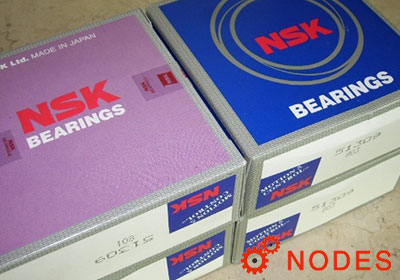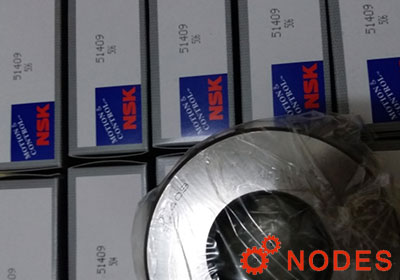NSK thrust bearings come in many designs and types bearings, including NSK thrust ball bearing, cylindrical roller thrust bearing, spherical thrust roller bearing, angular contact thrust ball bearing.
NSK Thrust Ball Bearings
NSK Thrust ball bearings are classified into those with flat seats or aligning seats depending on the shape of the outer ring seat (housing washer). They can sustain axial loads but no radial loads. For Single-Direction Thrust Ball Bearings, pressed steel cages and machined brass cages are usually used The cages in Double- Direction Thrust Ball Bearings are the same as those in Single-Direction Thrust Ball Bearings of the same diameter series.

Single-Direction Thrust Ball Bearings: Axial loads in one direction can be sustained.
Double-Direction Thrust Ball Bearings: Axial loads in both directions can be sustained by shaft sleeve.
NSK Thrust Roller Bearings
Available with cylindrical or spherical rollers, NSK's thrust roller bearings sustain only axial loads, but they are suitable for heavy loads and have high axial rigidity. Spherical thrust roller bearings contain convex rollers and have a self- aligning capability and are free of any influence of mounting error or shaft deflection. Standard cages are machined brass, where the E-type offers a pressed cage for high load capacity.
NSK Thrust Cylindrical Roller Bearings
These are NSK thrust bearings containing cylindrical rollers. They can sustain only axial loads, but they are suitable for heavy loads and have high axial rigidity.The cages are machined brass.
NSK Thrust Spherical Roller Bearings
These are thrust bearings containing convex rollers. They have a self-aligning capability and are free of any influence of mounting error or shaft deflection. Besides the original type, the E type with pressed cages for high load capacity is also available. Their bearing numbers are suffixed by E.
For horizontal shaft or high speed application, machined brass cages are recommended. For details, contact NSK. Since there are several places where lubrication is difficult, such as the area between the roller heads and inner ring rib, the sliding surfaces between cage and guide sleeve, etc., oil lubrication should be used even at low speed. The cages in the original type are machined brass.
Related numbers

NSK 51202 bearings
15mm x 32mm x 12mm

NSK 51204 bearings
20mm x 40mm x 14mm

NSK 51205 bearings
25mm x 47mm x 15mm

NSK 51206 bearings
30mm x 52mm x 16mm

NSK 51207 bearings
35mm x 62mm x 18mm

NSK 51108 bearings
40mm x 60mm x 13mm

NSK 51309 bearings
45mm x 85mm x 28mm






